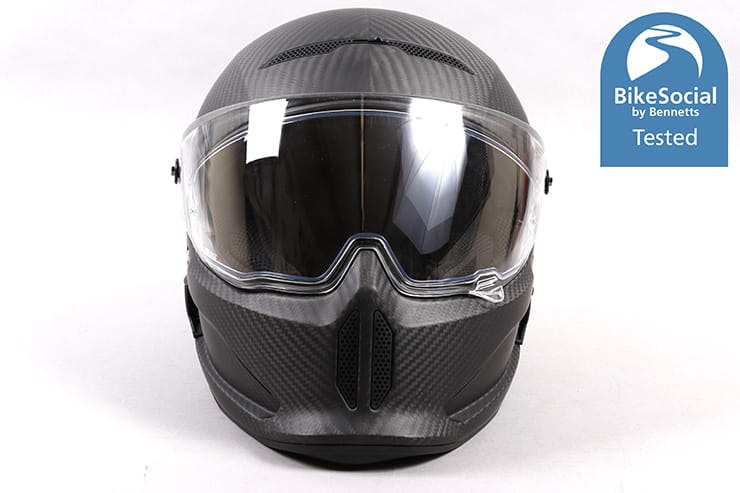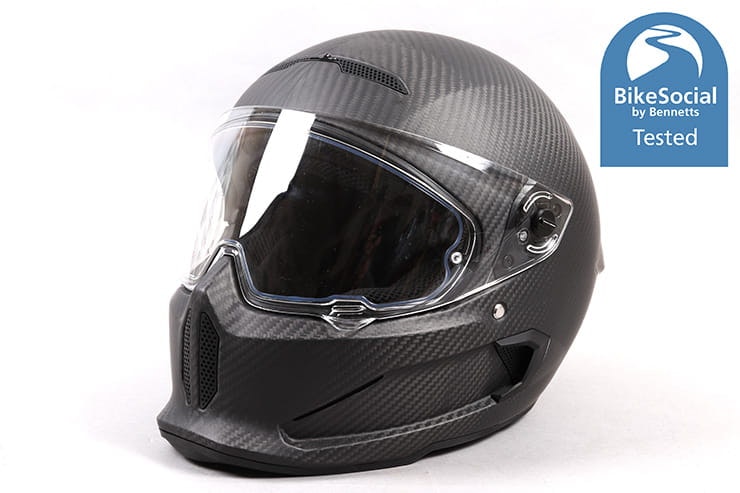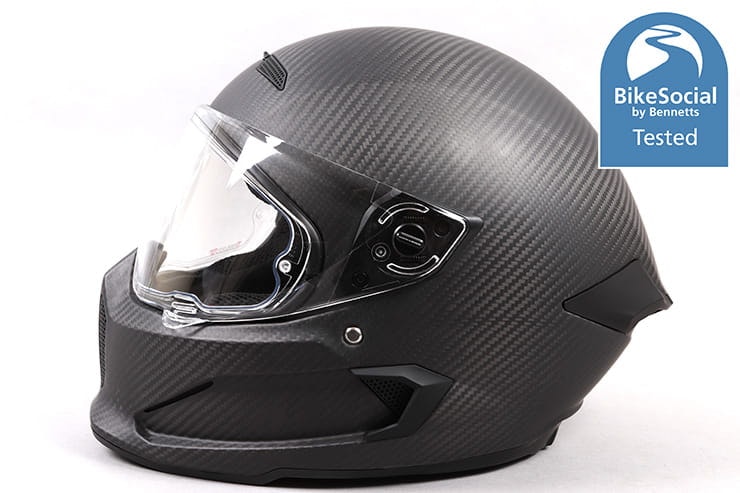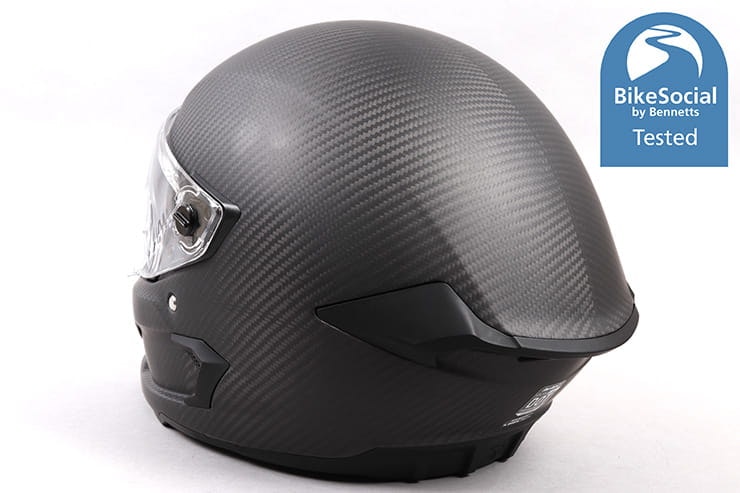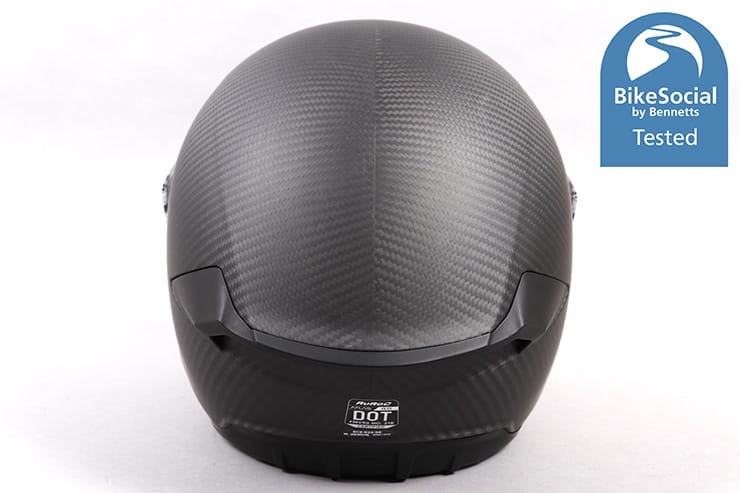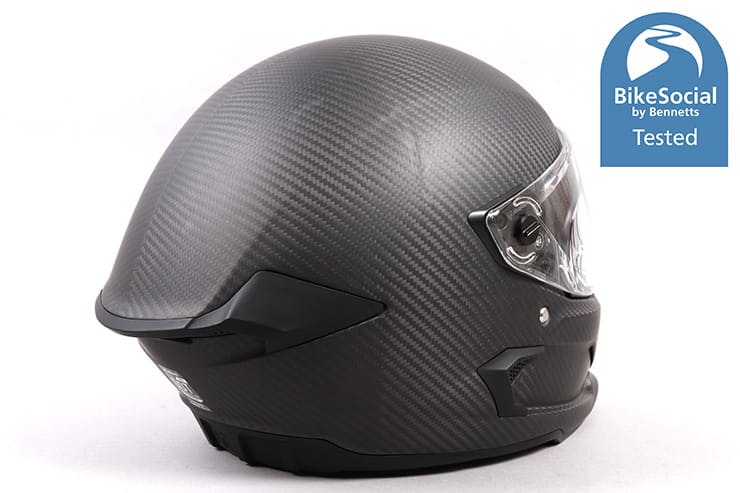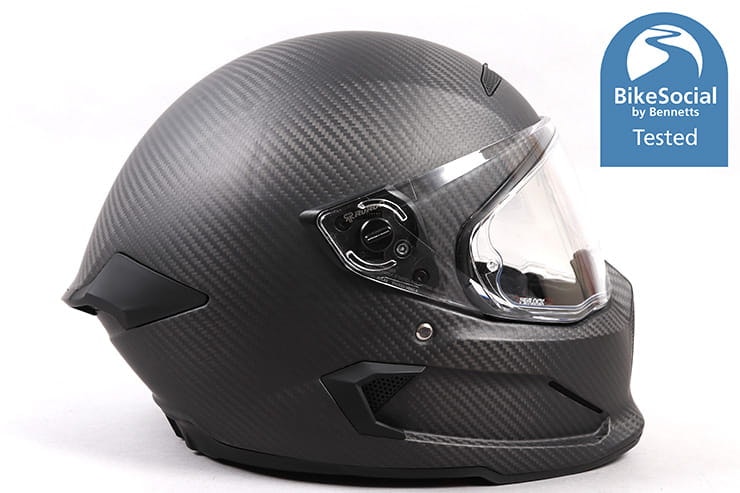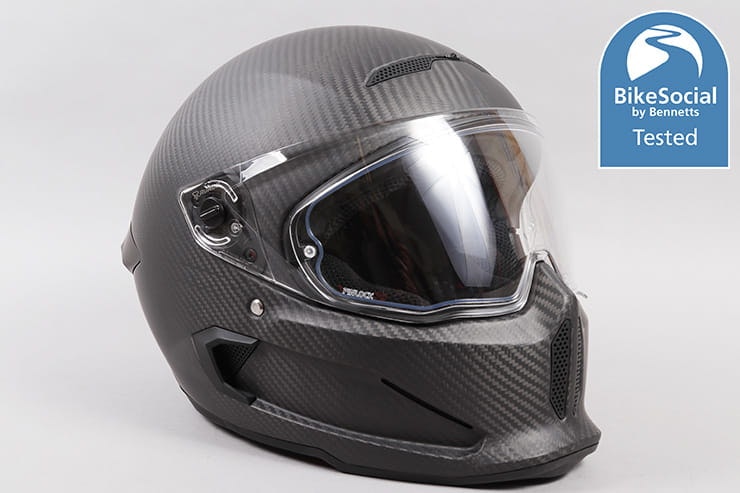Ruroc Atlas 4.0 review | Is this ECE 22.06 lid really any good?
By John Milbank
Consumer Editor of Bennetts BikeSocial
07.04.2022
Date reviewed: April 2022 | Tested by: John Milbank | RRP: From £375 | www.ruroc.com
The Ruroc Atlas 4.0 is the company’s first ECE 22.06-approved helmet, which means it meets the much more strict safety standards that, at the time of writing, only a relatively small number of lids have been certified to. With 12 additional impact zones and tougher thresholds, not to mention an oblique impact test that measures rotational acceleration – important to reduce brain injury due to it being whipped about in the skull – the new standard can give buyers confidence that they’re investing in the provably safest helmets on the market.
The streetfighter-esque styling is reminiscent of the old Simpson Bandits, and Ruroc claims the Atlas 4.0 has enhanced comfort, with a new approach that it says looks at helmet design with a fresh eye for the best performance.
Designed in the UK, Ruroc also offers ‘crash replacement’; costing an extra £30 when you buy the lid, this allows you to purchase a new part or helmet for 50% off the full RRP if you do have an accident in the first two years. You’ll need to supply the original receipt and return the damaged parts.
I’ve been using the Ruroc Atlas 4.0 since its launch in January on a variety of bikes, including the Yamaha Tracer 9 GT, BMW S1000XR and my Honda Grom to find out if it’s as good as the influencers say…
Among the provably safest helmets on the market
Well-placed emergency pull-tabs
Unique styling
Ineffective vents
Chin strap is a step backwards
Some questionable build quality
Outer shell
The Ruroc Atlas 4.0 has a carbon-fibre outer shell that’s coated in a matte lacquer in this ‘Raw Carbon’ version, which costs £475. Plain colours are £375, while graphics cost £425.
While the fairly radical styling can divide opinion, it reminds me of the Simpson Bandits that were so popular in the 1990s. Good to know: they were illegal, due to being certified for the totally different impacts associated with car racing, though the new versions are ECE 22.05 approved.
Getting the carbon fibre laid perfectly must be a challenge, and it does look excellent, with just one seam running through the centre.
I have to say, I love the look of the Ruroc, which is why I was so keen to give this helmet a try.
Weight
Claimed to be 1,600g +/- 50g, this ML Ruroc Atlas 4.0 weighs 1,713g on my scales. That’s heavier than the other ECE 22.06 lids we’ve tested: the Arai Quantic is 1,588g, while the flip-front Schuberth C5 is 1,695g. The Shoei NXR2 is just 1,392g.
However, while comparing lids in the hand will show a difference (and can be a great sales tactic), I’ve yet to find one that truly feels ‘too heavy’ on my head. What matters more is the wind resistance, and I noticed no excessive drag with the Ruroc.
Ventilation
The Ruroc Atlas 4.0 has a pair of vent holes at the chin, another pair on the top, and two always-open exhaust vents on the rear. The scoops on either side of the helmet – below the visor mechanism – are purely decorative, with no holes beneath them.
The chin vent is opened and closed from the inside, which makes it awkward to access. It makes little obvious difference as the helmet is naturally quite airy anyway, despite the increased material around the neck skirt.
The chin vent also – very unusually – doesn’t divert any air up across the back of the visor, which means my glasses tend to steam up a little more quickly in cold weather.
The top vent is made up of two very small holes, and no matter how much I tried, I couldn’t feel any difference in them being open or closed.
While the upper inside of the visor aperture has what look like vent holes in the lining, they don’t do anything.
Visor
The lack of any ventilation over the inside edge of the visor means the Pinlock is important to help reduce fogging, especially in colder weather. Unfortunately one isn’t supplied, so you’ll need to spend an extra £25 on the optional Pinlock 70, which is the mid-range anti-fog insert. 30 is the lowest-spec, 120 (sometimes called Evo) is the highest.
Cracking the visor just open with the left-hand tab gives some additional venting, though then setting to the next stage (about 2cm open) isn’t easy as the ratchet is quite stiff, so you’ll typically end up opening it fully then bringing it down to where you want it. There are six stages to the visor’s position in total.
The Ruroc’s visor gives a good field of view, with only the raised nose section being noticeable (but not distracting) when closed. Unfortunately the shape of the bottom edge causes distortion when the visor’s opened to its first stage, and this does get in the way.
A dark visor (for track use only, of course) is supplied with the Ruroc, and it gives it that finishing touch. Sadly though, swapping the visors (or removing one for cleaning) is less simple than it should be, thanks to the firmly-sprung attachment mechanism that uses a separate latch key that’s easy to drop and awkward to fasten. While you don’t need tools, this is a long way from the quick-release visors of most of the leading brands.
The visor seals well, with no water ingress apparent along the top edge.
Lining
The Ruroc’s lining is fully removable for easier cleaning, and includes four thin rows of Rheon – a non-Newtonian armour – that’s said to help in the lid’s meeting of ECE 22.06 for impact and rotational forces.
The cheek pads are made of multiple layers of foam and help provide a good, secure fit on my head. They also have integrated pull-straps to aid emergency responders in pulling the pads out and removing the lid without disturbing the neck, should the worst happen. These are tucked neatly away, forming useful loops when needed. Don’t worry – you can tuck them back in with something like a retracted pen if you pull them out for a look!
The helmet creaks a little when putting it on, and this is likely linked to the movement of the EPS (expanded polystyrene) inner shell. While not seeming to be a safety issue, it’s no less disconcerting to see this shift when you take the helmet off, leaving a thin strip of the EPS exposed in the visor aperture. This isn’t a one-off fault as the same movement was apparent in the SM-size Ruroc that I sent back.
Fastening
The Ruroc uses a ‘Fidlock’ fastener at the chin strap, which sees the two halves snap together with a powerful magnet and latch design. It’s no doubt secure as it passes certification, but it’s quite a fiddle to close and leave me wondering if I’ve done it correctly.
The most common fasteners used on modern helmets are the traditional double-D ring, or the newer micrometric ratchet.
Both of these designs ensure the strap is tight every time you put it on, but on the Ruroc the strap has to be set to the required length, then you’re stuck with that unless you go through the tedious and fiddly process of adjusting it again. This is a step back to the seat-belt buckle-style fasteners of the 1980s, so while it’s good to be different, I really don’t like what is an awkward to use, and in some ways inferior system.
If Ruroc wanted ease of use, I’d have preferred a ratchet-style strap. Otherwise, a double-D would have been more appropriate, and not really any more difficult to use than the ‘Fidlock’ here.
Fit
Do check your sizing – I first had an ‘SM’, or small-medium, but I couldn’t get it on. The ‘ML’ or medium-large was right for me. Of course, fit is entirely personal, but Ruroc offers a 14 day return or exchange.
While I haven’t tried a previous Ruroc, it appears the fit is a little different for the new model. ECE 22.06 doesn’t make helmets tighter – you only need look at lids like the Arai Quantic to see that – but the extra testing to ensure it doesn’t rotate off in a crash will be dealt with differently by various brands.
Overall I find the Ruroc fairly comfortable, but I do get some pressure on the lower rear of my head, around the neck skirt. As with any helmet, try it on before buying and concentrate on any pressure points that can get a lot more painful after an hour or so’s riding.
My glasses fit in the Atlas 4.0 fine, with no pressure on the sides of my head from the spectacle’s arms.
Noise
You need to wear earplugs with any helmet unless you never get over 40mph or so, but the Ruroc doesn’t sound unduly noisy.
For more information on why earplugs are vital with any helmet, and advice on which are the best, click here.
Ruroc Shockwave review | Bluetooth intercom system
The Ruroc Atlas 4.0 is ready for the optional £150 Shockwave Bluetooth Audio kit. This comes with a mic and speakers to quickly and easily instal, while the main unit with battery slots into the rear, held in place with small magnets.
Being a carbon-fibre helmet, the range is severely limited for rider-to-rider Bluetooth comms. I haven’t got a second Shockwave to see just how short it is, but Ruroc promotes its Chain app, which works with any Bluetooth intercom and phone to provide potentially unlimited range and any number of riders in a group.
PLEASE NOTE: as of June 2023, the Ruroc Chain app is unusable during our testing on Android, and reports on iOS are far from favourable. This is a significant problem for owners of Ruroc's Shockwave intercom, which has limited comms, so relies on the Chain app.
The controls on the Shockwave are extremely difficult to get to, being on the rear of the lid and having small buttons. I also found that, while I could skip music that was streaming from my phone, the play/pause button wouldn’t work. I couldn’t find any way of checking or updating the firmware.
The Shockwave has no FM radio, and while I appreciate the use of a USB-C connection for charging, when you attempt to unplug the cable, the whole unit pulls out of the bottom of the lid. It pushes back in again, but it’s another disappointment in the build quality of a helmet that’s competing with some of the most established names at this price point.
If you want to listen to music on your bike, there are a lot better options for less money than the Shockwave, and fortunately you should be able to fit an aftermarket intercom into the scoop that leads to the fake vent on the side. Keep in mind though that rider-to-rider range will always be limited on any carbon-fibre helmet.
Three alternatives to the Ruroc Atlas 4.0
The £475 of this Raw Carbon Ruroc puts it into Arai Quantic and Shoei NXR2 territory (though likely in plain colours only). In plain colours the £325 price point is more upper mid-range. Many will want the Ruroc for its styling, but here are some other options…
While not as radical in its styling as the Ruroc, the ECE 22.06-approved Shark Spartan RS is a cool design that’s available in full carbon for £379.99. Plain colours are £299.99, and they all come with a Pinlock 120 insert. We have one on review, so keep checking back at BikeSocial.co.uk.
If you want that Simpson Bandit look, you can get a Simpson from most Oxford Products dealers. The Simson Speed costs £249.99, while the Simpson Venom starts at £299.99 for plain colours, rising to £329.99 for graphics or £469.99 for carbon fibre. The Simpsons are currently approved to ECE 22.05, but if they achieve 22.06 we’ll review them.
The HJC RPHA 11 is £349.99 for plain colours, rising to £549.99 for the top in the range. We reviewed the £499.99 HJC RPHA 11 Nakri Carbon in April 2020 and were very impressed – hopefully the new models will achieve ECE 22.06.
These are just three of many alternatives – you can find all the helmets we’ve tested here and be sure to regularly check for the discounts available through BikeSocial membership.
Having the internal EPS shell rotate and expose itself when taking the lid off is concerning
Ruroc Atlas 4.0 review: Verdict
I wanted to love the Ruroc Atlas 4.0, and expected big things from it, but sadly I found it lacking in almost every respect. It’s perhaps telling that it arrived before the Yamaha MT-10 launch, and would have been a perfect choice for that bike, but I instead took something that simply worked much more effectively.
Poor venting, awkward handling and some disappointing design choices mean the Ruroc Atlas 4.0 is in too many ways form over function. As an ex-designer I should adore it, but at least its ECE 22.06 certification means that those who do buy it for its style, rather than modern functionality, can be safe in the knowledge that it’s among the safest helmets currently on the market.
BikeSocial members can save 10% on helmets and accessories with the exclusive Ruroc discount voucher code.
